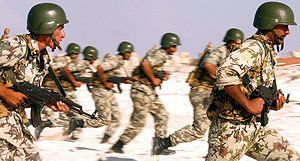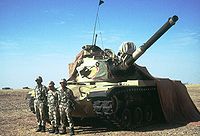Military of Egypt
From Wikipedia, the free encyclopedia
| Egyptian Armed Forces |
|
|---|---|
 Egyptian infantry during Operation Bright Star |
|
| Service branches | Egyptian Army Egyptian Navy |
| Leadership | |
| Commander-in-Chief and Minister of Defense | Mohamed Hussein Tantawi |
| Minister of Interior | Habib Ibrahim El Adly |
| Manpower | |
| Military age | 18-49 years old |
| Conscription | Conscripts without college degree serve three years as enlisted
Conscripts with General Secondary School Degree serve two years as enlisted Conscripts with college degree serve one year as enlisted or three years as reserve officer |
| Available for military service |
18,347,560, age 18–49 (2005) |
| Fit for military service |
15,540,234, age 18–49 (2005) |
| Reaching military age annually |
802,920 (2005) (2005) |
| Active personnel | 450,000 (ranked 11th) |
| Expenditures | |
| Budget | $2.5 billion (2006)+ $1.3 billion of U.S military aid annually (Possibly more [1]) |
| Percent of GDP | 3.1% (2006) |
The Armed Forces of Egypt are the largest on the African continent and one of the largest in the world (ranked 11th), consisting of the Egyptian Army, Egyptian Navy, Egyptian Air Force and Egyptian Air Defense Command.
Egypt maintains a large paramilitary force under the control of the Ministry of Interior. They number between 315,000 and 350,000 strong, including the reserve units and are known as the Central Security Forces. The government also has a relatively strong National Guard and Border Security Forces however they, unlike the Central Security Forces, come under the control of the Ministry of Defence and are reported to number 60,000 and 20,000 respectively, in addition to the Coast Guard that numbers 5,000 strong.
The Commander-in-Chief is Field Marshal Mohamed Hussein Tantawi and the General Chief of Staff is Lt. Gen. Sami Hafez Anan.
The armed forces inventory includes equipment from the United States, France, Italy, the United Kingdom, the former Soviet Union, and the People's Republic of China. Equipment from the former Soviet Union is being progressively replaced by more modern American, French, and British equipment, a significant portion of which is built under license in Egypt, such as the M1 Abrams tank.
To bolster stability and moderation in the region, Egypt has provided military assistance and training to a number of African and Arab states. Although not a NATO member, Egypt remains a strong military and strategic partner and is a participant in NATO's Mediterranean Dialogue forum. The Egyptian military is one of the strongest in the region[1], and gives Egypt regional military supremacy rivaled only by Israel [2], besides being the strongest in Africa [3][4]. Egypt is the only Arab country with a spy satellite and has launched another one in 2007.[5]
Contents |
[edit] The Egyptian Army

The armed forces inventory includes equipment from the United States, France, Brazil, the United Kingdom, the former Soviet Union, and the People's Republic of China. Equipment from the former Soviet Union is being progressively replaced by more modern American, French,and British equipment, a significant portion of which is built under license in Egypt, such as the M1A1 Abrams tank which makes Egypt the owner of the biggest number of latest generation MBT's in the region, and the second after Syria in case of the older generations.Also ranked better than the South African army.
[edit] The Egyptian Air Force
The Egyptian Air Force or EAF is the aviation branch of the Egyptian Armed Forces. Currently, the backbone of the EAF is the F-16. The EAF (planes and Pilot training) is considered to be the strongest in Africa and one of the strongest in the Middle East. The Mirage 2000 is the other modern interceptor used by the EAF. The Egyptian Airforce has 240 F-16s (plus 24 on order) making it the 4th largest operator of the F-16 in the World. It has about 579 combat aircraft and 149 armed helicopters as it continues to fly extensively upgraded MiG-21s, F-7 Skybolts, F-4 Phantoms, Dassault Mirage Vs, and the C-130 Hercules among other planes. The Air Force is undergoing massive modernization. Mikoyan confirmed that talks with Egypt are underway for the sale of 40 Mig-29SMT jet-fighters, with a possible additional batch of 60-80 planes.
[edit] The Egyptian Air Defense Command
The Egyptian Air Defense Command or ADF (Quwwat El Diffaa El Gawwi in Arabic) is Egypt's military command responsible for air defense. Egypt patterned its Air Defense Force (ADF) after the Soviet Anti-Air Defenses, which integrated all its air defense capabilities – antiaircraft guns, rocket and missile units, interceptor planes, and radar and warning installations.
Its current commander is Major General Abdel-Aziz Seif. It consists of 30,000 officers & soldiers plus 40,000 conscripts.
[edit] The Egyptian Navy
Although the Egyptian Navy is the smallest branch of the military, it is large by Middle Eastern standards. It has a total of 60,000 personnel.
The Egyptian Navy is known to be the strongest in the African continent, and the second largest in the Middle East after the Turkish navy in spite of the rapid growing of other countries navies within the region.
Some fleet units are stationed in the Red Sea, but the bulk of the force remains in the Mediterranean. Navy headquarters and the main operational and training base are located at Ras at Tin near Alexandria. The current commander is lieutenant general Mohab Mameesh.
See list of naval ships of Egypt for a list of vessels in service.
[edit] The Egyptian Paramilitary Forces
Paramilitary Forces number around 405,000 and consist of:
- Central Security Forces: under the control of the Ministry of the Interior. It is the law enforcement authority in the country. The Central Security Forces, number between 315,000 and 350,000 personnel, including reserve units.
- National Guard: under the control of the Ministry of Defense and numbers about 60,000 personnel and they are mainly for ceremonials and parades. The National Guard is not a part of the Corps, it is rather for the defence of the Presidential institution and the Capital.
- Border Guard Forces: under the control of the Ministry of Defense. The Border Guard is a lightly armed paramilitary unit of about 25,000 personnel, mostly Bedouins, responsible for border surveillance, general peacekeeping, drug interdiction, and prevention of smuggling. During the late 1980s, the force was equipped with remote sensors, night-vision binoculars, communications vehicles, and high-speed motorboats.
- Coast Guard: is responsible for the onshore protection of public installations near the coast and the patrol of coastal waters to prevent smuggling. With a force of 5,000 personnel, it has an inventory consisting of about thirty five large patrol craft (each between twenty and thirty meters in length) and twenty smaller Bertram-class coastal patrol craft built in the United States.
[edit] Egyptian Military Schools
There is an undergraduate military school for each branch of the Egyptian Military establishment, and they include:
- The Egyptian Military Academy
- The Egyptian Naval Academy
- The Egyptian Air Academy
- The Egyptian Air Defense Academy
- The Egyptian Military Technical College
- The Egyptian Technical Institute
- Nasser Military Academy
- College of the Commanders and the Chiefs of Staffs
- College of the Reserve Officers
[edit] See also
[edit] References
[edit] Notes
- ^ "title=Egypt%20--%20Britannica%20Online%20Encyclopedia Egypt". Britannica. http://www.britannica.com/EBchecked/topic/180382/Egypt#tab=active~checked%2Citems~checked title=Egypt%20--%20Britannica%20Online%20Encyclopedia. Retrieved 2009-03-31.
- ^ "[http://www.acpr.org.il/NATIV/2000-6/2000-6-shawnpinexs.htm The Egyptian Threat and the Prospects for War in the Middle East]". NATIV. November, 2006. http://www.acpr.org.il/NATIV/2000-6/2000-6-shawnpinexs.htm. Retrieved 2009-03-31.
- ^ "Egypt - Military". Global Oneness. http://www.experiencefestival.com/a/Egypt_-_Military/id/1289421. Retrieved 2009-03-31.
- ^ "Global Diversity: Winning Customers and Engaging Employees Within World Markets". Intercultural Press. 2006. http://books.google.com/books?id=VkOT4E8-Z_IC&pg=PA299&lpg=PA299&dq=strongest+military+Africa+Egypt&source=web&ots=FaYnW_qvQh&sig=x8kv5oRVQqmLLJPAYANO9qDyt7s&hl=en&sa=X&oi=book_result&resnum=9&ct=result#PPA299,M1. Retrieved 2009-03-31.
- ^ "Egypt to launch first spy satelllite". The Jerusalem Post. http://www.jpost.com/servlet/Satellite?cid=1167467733037&pagename=JPost%2FJPArticle%2FShowFull. Retrieved 2009-03-31.
[edit] Bibliography
- Egyptian Armed Forces
- CIA World Factbook
- FAS
- GlobalSecurity
- Further Reading: see Kenneth M. Pollack, Arabs at War: Military Effectiveness 1948-91, University of Nebraska Press, Lincoln and London, 2002, and Pollack's book reviewed in International Security, Vol. 28, No.2.
